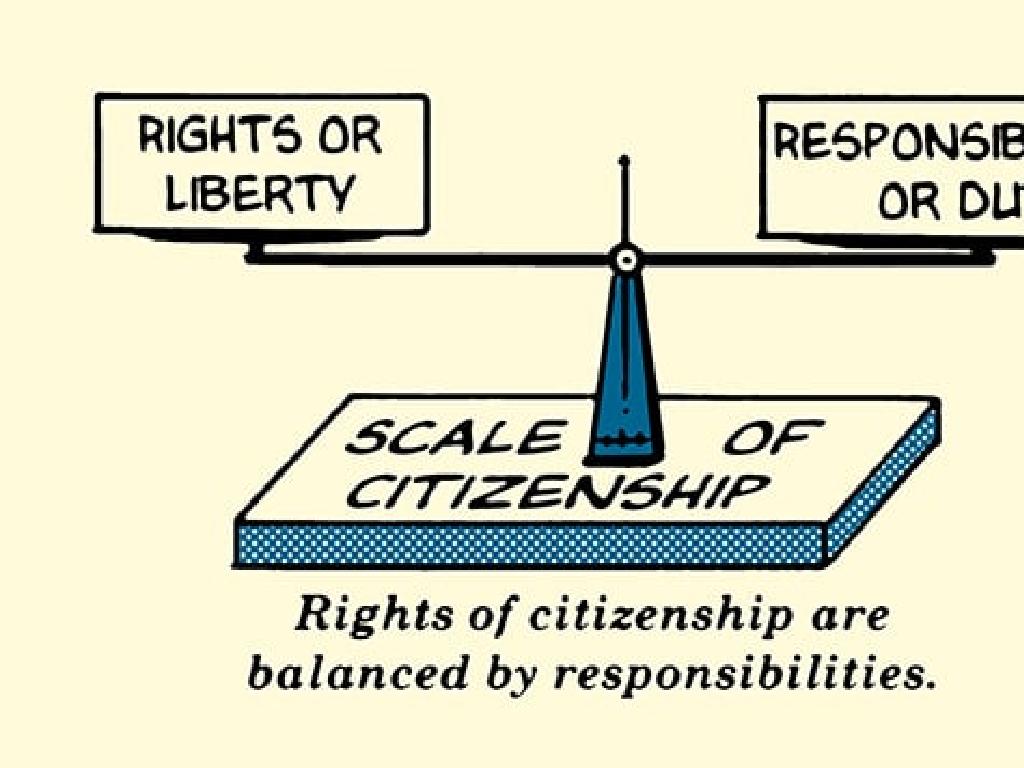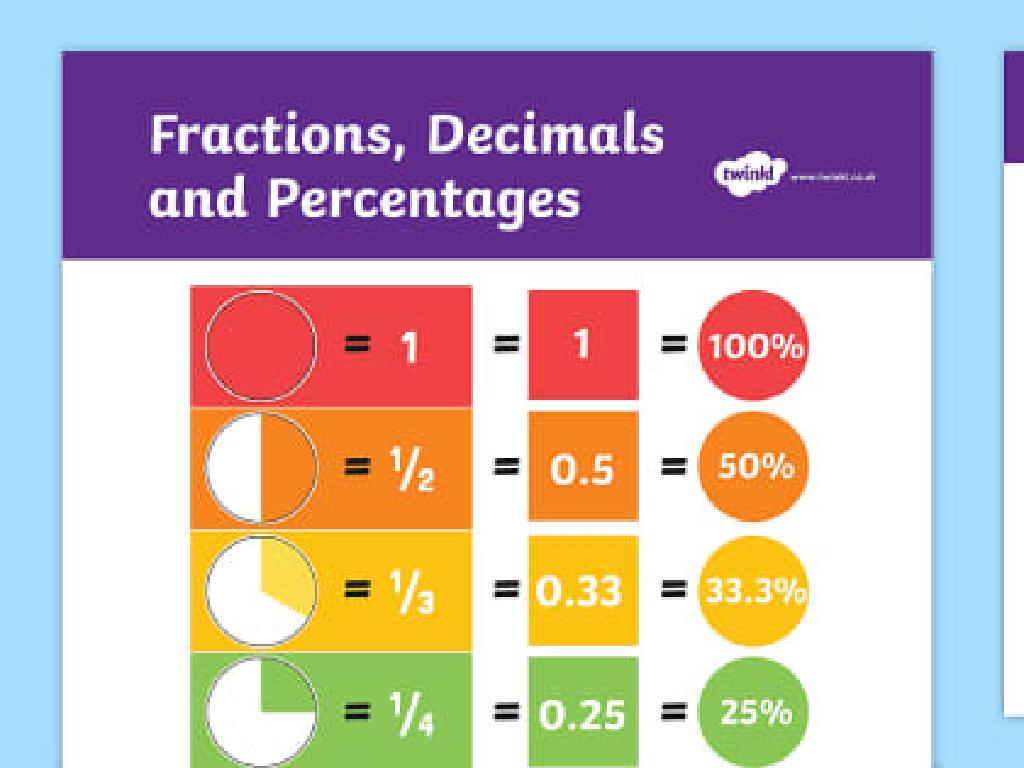Geometric Sequences
Subject: Math
Grade: Eighth grade
Topic: Sequences
Please LOG IN to download the presentation. Access is available to registered users only.
View More Content
Exploring Geometric Sequences
– Defining a mathematical sequence
– A sequence is an ordered list of numbers following a pattern
– Characteristics of geometric sequences
– Each term is multiplied by a constant to get the next term
– Common ratio in geometric sequences
– The constant factor between terms, e.g., in 2, 6, 18, 54, the ratio is 3
– Real-world geometric sequence examples
– Examples include population growth, interest rates, and fractal patterns
|
This slide introduces students to the concept of sequences in mathematics, with a focus on geometric sequences. Begin by explaining what sequences are and how they are used to represent ordered lists of numbers. Emphasize the defining feature of geometric sequences: each term is obtained by multiplying the previous term by a fixed number, known as the common ratio. Provide clear examples to illustrate this concept, such as population growth where each generation might be double the previous, or interest rates where money grows by a certain percentage each year. Encourage students to think of other examples where they might encounter geometric sequences in their daily lives.
Introduction to Geometric Sequences
– Define geometric sequences
– A sequence where each term is multiplied by a constant to get the next term.
– Understand the common ratio
– The constant factor between every term in the sequence.
– Real-life geometric sequence examples
– Examples include population growth, interest rates, and fractal patterns.
– Observe sequences in nature
– Patterns like nautilus shells or pine cones follow geometric sequences.
|
This slide introduces the concept of geometric sequences, a fundamental topic in mathematics that applies to various real-world scenarios. A geometric sequence is characterized by a common ratio, which is the fixed number that each term is multiplied by to produce the next term. Emphasize the importance of identifying this ratio as it allows for the prediction of future terms in the sequence. Provide tangible examples that students can relate to, such as the rapid growth of a savings account due to interest, or the way certain plants grow and reproduce. Encourage students to think of other examples they may have observed in their daily lives or in nature, fostering a connection between mathematical concepts and the world around them.
Exploring Geometric Sequences
– Geometric sequence formula
– a_n = a_1 * r^(n-1), where a_n is the nth term, a_1 is the first term, and r is the common ratio
– First term and common ratio
– a_1 is the starting number, r is the factor we multiply by to get the next term
– Calculating sequence terms
– Use the formula to find any term in the sequence
– Practice with examples
– Example: For a_1 = 3 and r = 2, find the 4th term: a_4 = 3 * 2^(4-1) = 24
|
This slide introduces students to the concept of geometric sequences, a key topic in algebra. The formula a_n = a_1 * r^(n-1) is crucial for understanding how to find any term in a geometric sequence. Emphasize the roles of the first term (a_1) and the common ratio (r), as these are fundamental in determining the sequence’s behavior. Provide practice problems where students calculate various terms in a sequence to solidify their understanding. Encourage students to work through the example provided and create additional examples as homework to further their grasp of geometric sequences.
Visualizing Geometric Sequences
– Graphing sequences on a grid
– Plot points to see the pattern of a sequence
– Exponential growth vs decay
– Growth: values increase, Decay: values decrease
– Bacteria growth example
– Population doubles at consistent intervals
– Interest calculation example
– Money grows over time with compound interest
|
This slide aims to help students visualize geometric sequences through graphing, understanding the concepts of exponential growth and decay, and seeing how these ideas apply in the real world. When graphing, students should notice that geometric sequences form a curve, not a straight line. Exponential growth means the values get larger and decay means they get smaller, both at a consistent rate. Real-world examples like bacteria growth show how populations can double at regular intervals, while interest calculations demonstrate how investments increase over time. Encourage students to think of other examples where they might encounter geometric sequences in their daily lives.
Exploring Geometric Sequences
– Finite vs Infinite sequences
– Finite have limited terms, infinite continue indefinitely
– Convergent vs Divergent
– Convergent sequences approach a limit, divergent do not
– Sum of a Geometric Series
– Sum can be found using S_n = a(1 – r^n) / (1 – r) for finite series
– Practical applications
|
This slide introduces students to the key properties of geometric sequences. A finite geometric sequence has a specific number of terms, while an infinite one goes on forever. Convergent geometric sequences have a common ratio between consecutive terms that is between -1 and 1, causing the sequence to approach a certain value. Divergent sequences, on the other hand, do not approach a limit and can grow indefinitely. Understanding the sum of a geometric series is crucial for solving problems involving finite geometric sequences. The formula provided is for the sum of the first n terms of a finite geometric series, where ‘a’ is the first term, ‘r’ is the common ratio, and ‘n’ is the number of terms. Encourage students to apply these concepts to real-life situations, such as calculating interest over time or predicting population growth.
Geometric Sequences: Practice Problems
– Identify common ratio and next term
– Use consecutive terms to find the ratio, then multiply the last term by this ratio to find the next term.
– Find the 10th term in a sequence
– Use the formula a_n = a_1 * r^(n-1) where n is the term number and r is the common ratio.
– Calculate sum of first 5 terms
– Sum is found using S_n = a_1 * (1 – r^n) / (1 – r) for the first n terms.
– Apply formulas in exercises
|
This slide provides practice problems to help students apply their knowledge of geometric sequences. The first problem reinforces the concept of the common ratio and how it can be used to find subsequent terms. The second problem requires students to use the geometric sequence formula to find a specific term far along in the sequence. The third problem introduces the formula for the sum of a geometric series, which is a crucial concept for understanding how these sequences behave as they progress. Encourage students to work through these problems step-by-step and to check their work by verifying that each term fits the pattern of the sequence. Provide additional examples if needed and consider pairing students for collaborative learning.
Class Activity: Crafting Geometric Sequences
– Pair up to create a geometric sequence
– Exchange sequences with another pair
– Calculate the 5th term of the received sequence
– Use the formula a_n = a_1 * r^(n-1) to find the 5th term
– Discuss the methods used for finding the 5th term
– Share strategies and understanding of the formula
|
This activity is designed to reinforce students’ understanding of geometric sequences through collaborative learning. By creating their own sequences, students apply their knowledge of geometric sequences in a practical way. Exchanging sequences with peers adds an element of surprise and tests their ability to analyze sequences created by others. Calculating the 5th term requires students to use the geometric sequence formula, which solidifies their comprehension of the sequence’s properties. During the discussion, encourage students to explain their thought process and the steps they took to arrive at the solution. This will help them articulate their understanding and learn from each other’s approaches. Provide guidance on using the formula and ensure that each group has a chance to present their findings.
Wrapping Up: Geometric Sequences
– Recap: What are Geometric Sequences?
– A sequence with a constant ratio between successive terms
– Significance in Math & Real Life
– Used in finance, computing, and nature
– Transition to Arithmetic Sequences
– Understanding the contrast with geometric sequences
– Homework: Find real-life examples
– Look for patterns in nature, architecture, or savings
|
As we conclude today’s lesson on geometric sequences, remind students of the key concept: a sequence where each term after the first is found by multiplying the previous one by a fixed, non-zero number called the ratio. Emphasize how these sequences are not just theoretical but are applied in various fields such as finance (interest rates), computer science (algorithm complexity), and biology (population growth). Transitioning to arithmetic sequences in the next lesson will allow students to compare different types of sequences and their applications. For homework, encourage students to find and bring examples of geometric sequences they observe in their daily lives, fostering a connection between mathematical concepts and the real world.






